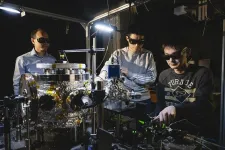(Press-News.org) An analysis of 12 years of data collected from over 500 hospitals in 25 different states shows that weather, geographic location, and urban or rural location all appear to influence hospitalizations for waterborne infectious diseases, according to a study published August 7, 2024 in the open-access journal PLOS Water by Victoria Lynch and Jeffrey Shaman from Columbia University.
Waterborne infectious diseases caused by bacteria, parasites, and viruses still affect over 7,000,000 people annually in the United States. Lynch and Shaman analyzed potential links between weather and hospitalizations for waterborne infectious diseases, specifically looking at whether these associations were influenced by drinking water source, location (rural/urban), and region.
The authors looked at hospitalizations caused by 12 specific water-borne pathogens, including bacteria like Escherichia coli, parasites like Cryptosporidium, biofilm-forming bacteria such as Pseudomonas and the pathogen causing Legionnaires’ disease—distinct from other bacterial pathogens because they naturally inhabit environmental water—and Norovirus. They used data from 516 hospitals in 25 states collected over 2000-2011 as part of the National Inpatient Sample (NIS) from the Healthcare Cost and Utilization Project (HCUP), along with weather and soil data from the NASA/ NOAA North American Land Data Assimilation System 2 (NLDAS-2) dataset.
There were 57,335 hospitalizations for waterborne disease between 2000 and 2011 from 516 hospitals in the United States. The biofilm-forming bacteria comprised nearly 81 percent of all hospitalizations (66 percent due to respiratory Pseudomonas infections alone.) Hospitalization rates for enteric and biofilm-forming bacterial pathogens were significantly higher in areas that used groundwater as a drinking water source instead of surface water. They also found that precipitation, water runoff, and rural locations were positively associated with hospitalizations for some enteric bacterial and parasitic infections, particularly in the Midwestern region. Specifically, parasitic hospitalizations (predominantly due to Cryptosporidium) increased 9 percent (95% CI: 4%-15%) with a 1-SD increase in precipitation. Conversely, hospitalizations for biofilm-forming bacterial infections were associated with soil moisture (a proxy for flooding). Incidences of Legionnaires’ disease specifically increased 124 percent (95% CI: 90%-157%) with a 1-SD increase in soil moisture, and were the only infection more common in urban areas. In general, associations between hospitalization rates and meteorological conditions, location, and drinking water source varied depending on the specific pathogens.
The authors note they weren’t able to include data on specific water quality (critical to assess the probable route of exposure for pathogens that can also be present in tainted food, like E. coli), or data from much of the Southeast (where states did not report monthly data to HCUP). Lynch and Shaman hope future work will be able to incorporate this information and additionally track outbreaks linked with extreme weather events to further clarify the links between hydrometeorology and waterborne diseases.
The authors add: "Our results show how analyses focused on specific pathogens can provide insight into distinct routes of exposure and risk factors for waterborne infectious diseases. This work can help inform weather preparedness efforts, which is particularly important as heavy rain becomes more severe and frequent in a warming climate."
#####
In your coverage please use this URL to provide access to the freely available article in PLOS Water: https://journals.plos.org/water/article?id=10.1371/journal.pwat.0000206
Citation: Lynch VD, Shaman J (2024) Hydrometeorology and geography affect hospitalizations for waterborne infectious diseases in the United States: A retrospective analysis. PLOS Water 3(8): e0000206. https://doi.org/10.1371/journal.pwat.0000206
Author Countries: United States
Funding: V.L. was supported by a training grant from the National Institutes of Health (NIH; grant no. T32ES023770); both authors were supported by NIH grant no. R01AI163023. The funders had no role in study design, data collection and analysis, decision to publish, or preparation of the manuscript.
END
Hydrometeorology and location affect hospitalizations for waterborne infectious diseases in the US
2024-08-14
ELSE PRESS RELEASES FROM THIS DATE:
Alzheimer’s cognitive decline predicted by patient’s age, sex, and irregular heart rhythm
2024-08-14
Older age, female sex, irregular heart rhythms, and daily activity levels can help to predict how much Alzheimer’s Disease patients’ cognitive function will decline, and how much they will depend on their caregivers over the next two years. The results suggest new ways to predict cognitive decline in patients, and that caregivers need to be considered in treatment plans. 'Liane Kaufmann from the Ernst von Bergmann Clinic in Potsdam, Germany, Josef Marksteiner from the General Hospital in Hall, Austria, and colleagues present these findings in the open access journal PLOS ...
Gender-sensitive job titles may affect women’s interest in job ads
2024-08-14
A new study suggests that the use of gender-sensitive language in the title of job advertisements may influence the level of interest demonstrated by female potential applicants. Dominik Hetjens of Technische Universität Dresden, Germany, and Stefan Hartmann of Heinrich-Heine-Universität Düsseldorf, Germany, present these findings in the open-access journal PLOS ONE on August 14, 2024.
German is one of many languages in which every noun is grammatically masculine, feminine, or neutral. For instance, ...
CNIO researchers discover a 'switch' for the desire to engage in physical activity: Two proteins that get activated in the muscle during exercise
2024-08-14
"We have discovered a muscle-brain pathway that controls the eagerness to train more when we exercise," explains Guadalupe Sabio, a researcher at the Spanish National Cancer Research Center (CNIO).
One of the proteins identified activates the area of the brain that controls movement. Obese patients have lower blood levels of this protein.
This result suggest it may be possible to develop drugs for people specially in need of the benefits that come from exercise, but are reluctant to do it.
The ...
A taste for carbon dioxide
2024-08-14
Nitrogenases are among the most geochemically important enzymes on Earth, providing all forms of life with bioavailable nitrogen in the form of ammonia (NH3). Some nitrogenases can also directly convert CO2 into hydrocarbon chains, making them an exciting target for the development of biotechnological processes. A team of researchers in Marburg, Germany, led by Max Planck scientist Johannes Rebelein, has now provided a comprehensive insight into the substrate specificity and preferences of nitrogenase. Their results challenge the current understanding of nitrogenases and highlight their potential for sustainable bioproduction.
Nitrogen is one of the main building blocks ...
US companies' global market reach linked to cloud computing use
2024-08-14
UNIVERSITY PARK, Pa. — U.S. firms that use cloud computing services are more likely to export their products and services, according to a new study by researchers at Penn State and the U.S. National Science Foundation (NSF). The team said the findings were stronger for firms located outside of large cities and demonstrate the need for expanded availability of the high-speed internet required for cloud computing to support economic development.
The study, which also found that cloud-using firms exported goods and services even more than exporting firms ...
Lake Erie walleye growth is driven by parents’ size, experience
2024-08-14
COLUMBUS, Ohio – Parent size and the conditions in which actively spawning adults lived are the most influential factors affecting growth of Lake Erie walleye, a new study has found.
The findings surprised the scientists, who expected recent temperatures and food availability to have the highest impact on walleye growth.
Cold winters and more sizable mothers were associated with faster growth in 3- to 5-year-old walleye offspring, the analysis showed, suggesting that warmer winters that come with ...
Texas Tech University joins US DOE’s $44 million carbon storage project
2024-08-14
The U.S. Department of Energy’s (DOE’s) Office of Fossil Energy and Carbon Management (FECM) has selected Texas Tech University as one of nine university and industry-led projects to split $44.5 million in federal funding to advance commercial-scale carbon capture, transport and storage across the U.S.
With an award just over $6.2 million, Texas Tech intends to implement and accelerate the equitable and environmentally responsible deployment of storage-based carbon management projects in the Permian Basin. The team will provide technical and engagement support for stakeholders to develop a framework ...
New study reveals loophole in digital wallet security—even if rightful cardholder doesn’t use a digital wallet
2024-08-14
Digital wallets — like Apple Pay, Google Pay and PayPal — are projected to be used by more than 5.3 billion people by 2026. While these wallets promote increased security over traditional payment methods, reliance on outdated authentication methods and prioritizing convenience over security leaves digital wallets vulnerable, according to new research led by computer engineers at the University of Massachusetts Amherst.
“What we have discovered is [that] these digital wallets are not secure,” says Taqi Raza, assistant professor of electrical and computer engineering and an author on the paper. “The main reason is that they have unconditional trust between ...
Researchers discover new way inflammation impacts cell communication
2024-08-14
INDIANAPOLIS – Indiana University School of Medicine researchers have made significant progress in understanding how cells communicate during inflammation. The study, recently published in PNAS, was conducted over a period of five years and focused on the molecules that enable cells to function during inflammation, particularly in the central nervous system where diseases like multiple sclerosis occur.
“Communication is key in any relationship, even at the level of cells that cause disease,” said Mark Kaplan, PhD, chair of the Department of Microbiology and Immunology at the IU ...
Purdue physicists throw world’s smallest disco party
2024-08-14
Physicists at Purdue are throwing the world’s smallest disco party. The disco ball itself is a fluorescent nanodiamond, which they have levitated and spun at incredibly high speeds. The fluorescent diamond emits and scatters multicolor lights in different directions as it rotates. The party continues as they study the effects of fast rotation on the spin qubits within their system and are able to observe the Berry phase. The team, led by Tongcang Li, professor of Physics and Astronomy and Electrical and Computer Engineering at Purdue University, published their results ...





